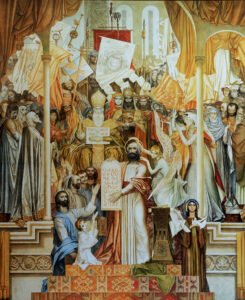
In the month of October, Armenians all over the world celebrate the Feast of the Holy Translators. The Holy Translators were a group of Armenian scholars, headed by two towering Armenian churchmen, St. Sahag and St. Mesrob, who laid the foundations of Armenian literature in the fifth century A.D. That century was known as the Golden Age of Armenian Literature.
In order to understand and appreciate the magnitude of the work of the Holy Translators, one has to know the political and religious situation of Armenia at that time.
In 387 A.D., the two superpowers of the era, Byzantium and Sasanid Dynasty of Persia, had partitioned Armenia into two sections, Western and Eastern Armenia. In Western Armenia, the official government language was Greek, while in Eastern Armenia, it was Persian. Besides these two languages, Syriac was also used because of its wide usage in religious literature. In fact, all Bible readings and liturgy were read from either Greek or Syriac texts and translated or interpreted by men who were known as “Translators.”
St. Sahag Bartev (348-438) and St. Mesrob Mashtots (361-439) saw the gravity of the political and religious state of the Armenian nation. They realized the importance of a literary Armenian language for the propagation of the Christian faith among Armenians. They knew that without the Bible in the hands of the lay people, the Armenian Church would not grow and could not stand very long in the midst of the pagan world.
St. Sahag and St. Mesrob also realized that a common literary language would unite the Armenian people in the Byzantine and Persian sections of Armenia. King Vramshabouh (Eastern Armenia) could see their logic, and thus, he lent his financial and moral support.
The only thing lacking was an Armenian alphabet. St. Mesrob was commissioned to do the task: inventing an Armenian alphabet as a tool for evangelism as well as a unifying force.
Mesrob traveled extensively and examined different alphabets. Finally, in 406 A.D., he invented the 36 letters of the Armenian alphabet.
The invention of the Armenian alphabet ushered in a new age of intellectual and spiritual enlightenment. The Armenian literary language and literature freed the Armenian people from the domination of the Persian, Syriac and Byzantine cultures. With the establishment of schools and the proliferation of writing, wider horizons opened up to the people, and their national consciousness was solidified. A host of disciples were trained under the guidance of St. Sahag and St. Mesrob, ushering in a new period of translating the Bible and other major Christian and philosophical texts into Armenian.
The group of scholars who launched the venture of translation of the Bible and other works came to be known as “The Holy Translators” or “Soorp Tarkmanitchk.”
The first translation of the Bible into Armenian, starting with the Book of Proverbs, was made from one version of the Syriac text, probably the Pershitta.
There was a second translation of the Bible into Armenian from the Greek Septuagint Bible under the supervision of Catholicos St. Sahag. The final revision was rendered between the years 432-438, and in 438, Catholicos Sahag approved it and authorized its use in the Armenian Church.
We owe an eternal debt to St. Sahag and St. Mesrob, the chief architects of the Golden Age of Armenian Literature, and their venerable disciples, the Holy Translators, who became a source of inspiration, generation after generation, to numerous Armenians throughout our history.



Be the first to comment